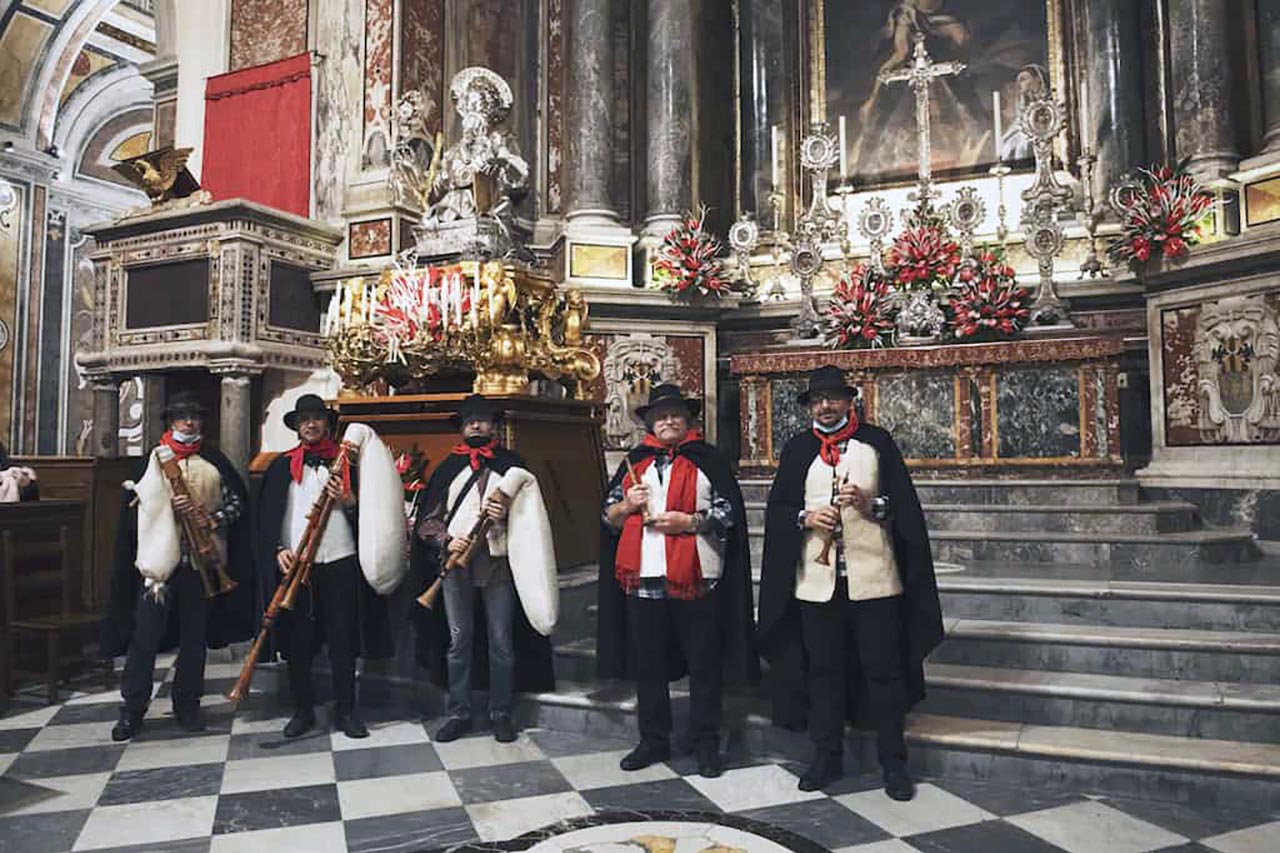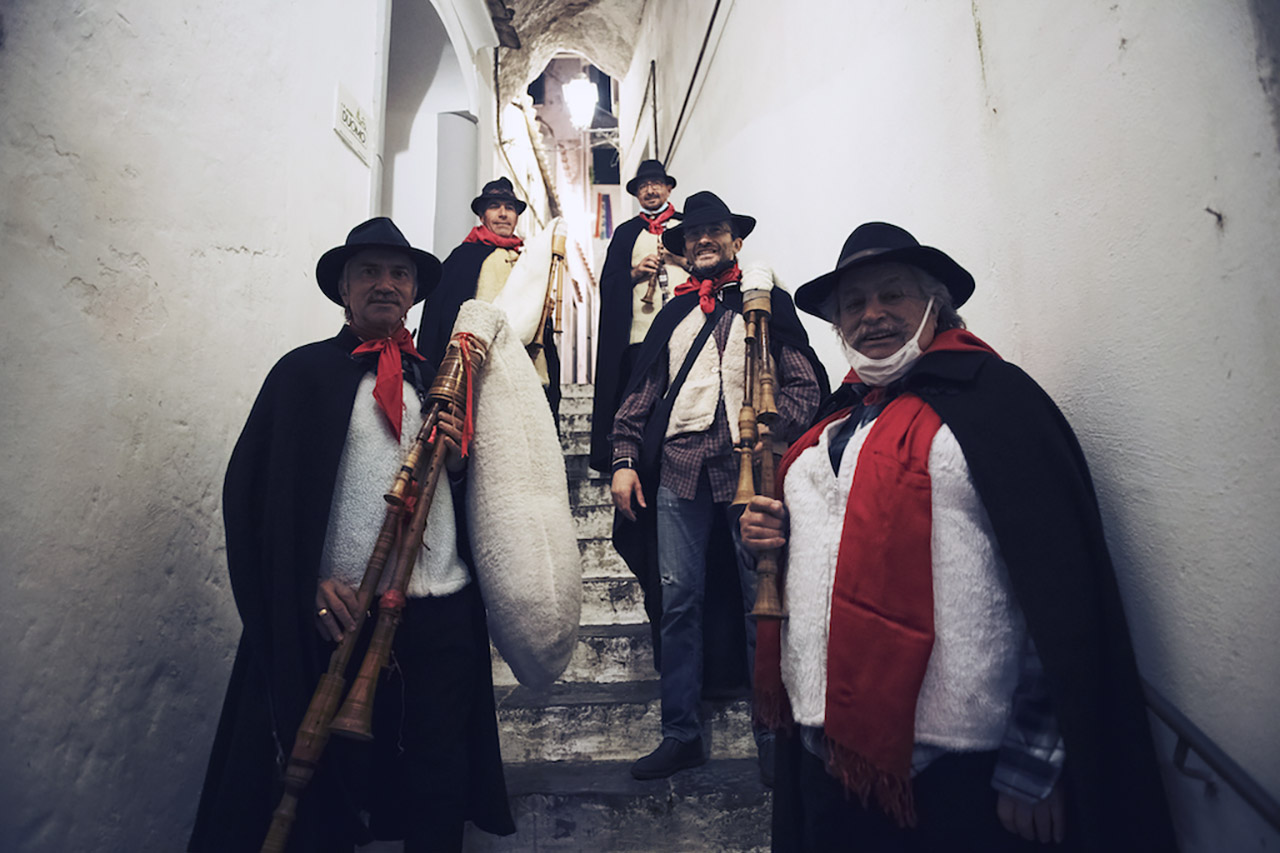They parade in the square and the city’s alleys, knocking from door to door, wishing good luck to the families.
December 12th, 202. By Francesca Faratro, photo by Emanuele Anastasio
Their sounds are ancient lullabies, musical interpretations of the melodies that made the Christmas atmosphere a bit magical for everyone. The bagpipers, authentic musicians dressed up for the party, on stage in the Amalfi Coast streets and beyond for Christmas, are figures dating back to antiquity.
Between history and legend
The bagpiper originates in Archaic Greece and is linked to God Pan’s legendary character. It is said that the priests, to celebrate this divinity, created the bagpipe to represent the cosmic union between the male and female elements. This occasion, recurrent on the winter solstice, represented the sun’s rebirth, compared later, with the advent of Christianity, to the birth of the Baby Jesus. Pan, God of Shepherds, was related to the pastoral activity.
On the occasion of transhumance, they were the shepherds who, praying to their protector, played and intoned songs that later became traditional. The Roman emperor Nero, fond of music, used to play the archaic instrument in Latin called utriculus. Later, St. Francis of Assisi, in 1100, inserted the bagpipers into the crib. In everyone’s imagination, they, with the lullabies, witnessed the birth of the Child Jesus.
Clothes and luck
The bagpipers, adorned with traditional clothes, with calves wrapped in fur, are often depicted with a hat and distinguished by a red detail, often shown in the sash at the waist or in the pocket handkerchiefs of the jacket. The image of the bagpiper in the Neapolitan area is also connected to superstition and luck.
On the occasion of a birth or a new home, many people open their doors to bagpipers who sing sweet good-luck melodies. Never alone, always in pairs or often in a group, they respect a structured hierarchy: it is the youngest who plays the ciaramella, or the traditional flute, while the older one is entrusted with the task of playing the bagpipe.

The musical repertoire
Their repertoire, consisting of simple melodies that have become known to all over the years, contains popular songs, Tu Scendi Dalle Stelle, the Italian version of Quann Nascett Ninno, with text Neapolitan written by Sant’Alfonso Maria Dè Liguori. This saint spread Christianity through his songs, transmitting them to anyone who listened.
The Amalfi Coast’s rituals
In 1992 in Amalfi, La Zampogna group aimed to keep this tradition alive. The idea came from Franco D’Amato, a shawm player and group founder. Following his mother’s advice, he began playing the bagpipe alone or with his friend Carmine Pinto.
After several trials, they put together a harmonious duo, among the first on the Amalfi Coast. The ensemble expanded so much that Franco also taught the art of bagpiping to Stefano Pinto and Andrea Laudano. Other ciaramella players joined them: Andrea Ingenito, Pietro La Grotta, and Federico Pizzoferro.
“Playing the bagpipe is very difficult. You need technique and passion. We animate the holidays. However, we carry the real celebration in our hearts. We stage the coming of the shepherds and dress like them. Cloth cloak, sheep’s wool bodice, boots, and headdress – says the bagpiper Stefano Pinto – We go out in procession with the first light of dawn: at five in the morning, when it is still dark. We do this both on the feast day of Saint Andrew the Apostle on November 30 and December 8 on the Immaculate Conception. On these occasions, the housewives prepare donuts and hot chocolate for us, a welcome and a cuddle to continue our journey.”

The sacredness of hospitality
In Amalfi’s hamlets, the musical procession is followed by a suggestive custom: from the main church Jesus Child is brought from home to home, where the real magic happens.
“We are greeted with rosoli, different zeppole, sweets, and traditional preparations that cheer up the party and the festive moment. Bringing our sounds to people’s homes is exciting, but it’s also lovely to feel the affection of people who, through their specialties, change from family to family. In Vietri, for example, struffoli triumph, fried pasta balls, here characterized by abundant orange peel. Our passion is prayer – Stefano continues excitedly – Through the sounds of our bagpipes, we raise a hymn that permeates our soul. We sing with our hearts in our hands. We pass on the tradition and pass it on to everyone, from the youngest to the elderly, who, unfortunately, can no longer leave the house. To play the bagpipe is to bring joy, to shine a light on the coming of Christ to the world, and to bring the true meaning of Christmas into everyone’s heart.”
The continuity of tradition
Fewer and fewer young people are approaching this passion, perhaps afraid of the difficulty behind every instrument, seen as a complicated element of history.
The teachings are transmitted from father to son, following a natural order that brings the little ones closer from childhood when, in love with the typical sounds, they decide to make them their own over time.
